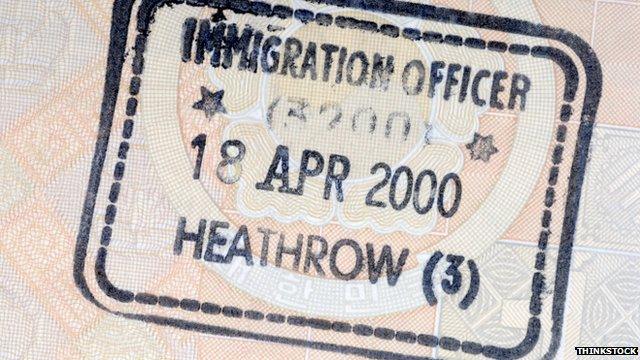Why migration is changing almost everything
- Published
- comments

Permission to enter: But will the bearer stay?
Everything is changing. Well, almost everything... That's the message in the projections calculated by Oxford University's Migration Observatory team who have come up with a fascinating glimpse at the shape of England.
The BBC has published figures from Oxford which, although they have limitations, tell us a great deal about the story of modern migration.
And it is a tale of change and movement which challenges historic notions of how migration works.
But let's start with what these figures are not.
The headline suggests immigration has added more than half a million to the population over the last three years - and that would mean the foreign born population has probably reached eight million people.

Find out more about migration where you live on Inside Out, BBC1, 7.30pm on Friday night - and afterwards on the iPlayer.

But that needs to be put firmly in a context which says "don't take it as gospel".
The projections created by Migration Observatory do not claim to be cast-iron indisputable figures - that is what official national statistics are for.
Instead, they are an attempt to give us an idea about what kind of role immigration is playing in each community - although for statistical reasons they exclude Scotland, Wales and Northern Ireland.
The Oxford team decided to carry out this exercise because there is currently no official estimate for the migrant population.
Every three months, the Office for National Statistics comes up with estimates for how many people are coming and going from the country.
This is drawn from the International Passenger Survey - a special questionnaire of some of the people who pass through our key ports.
But we only find out for sure how many of them have settled at the census which only comes every decade.
In between, there are annual population estimates - and an important part of working out those is to look at the Labour Force Survey. This is a detailed regular analysis of the employment circumstances of households.
We won't know the official 2014 population estimate until the summer - long after the General Election. The annual estimates that come from the Office for National Statistics are considered to be robust and reliable, external. But the practical challenges of working out what is going on means that we only ever learn a true and final figure for migrants at the census - and the next one is in 2021 - at least two elections away.
So Oxford's projections are an alternative attempt to highlight trends and themes while we drum our fingers waiting for official data.
So that said, what do these projections tell us?
The Migration Observatory team think every local authority in England may have seen change because of immigration since 2011. You can find the projection for where you live on their website, external.
There are huge variations which relate to specific local circumstances - but it is change nonetheless.
Two-thirds of the change has come from new arrivals from the European Union, particularly in areas which have seen a high demand for cheap labour.
European Migration
This effect can be seen in a map which projects how Oxford thinks EU workers are now distributed across the nation.
London is by far and away the most European of the regions. The 2011 census found that 711,000 people in the capital were from elsewhere in the European Union. The projections suggest that has jumped by 161,000 in just three years. There are large increases in many other areas. The East of England's farms and food industry has continued to suck in EU workers and their families - albeit at a slightly slower rate - and there has also been growth in the regions where the economic pick-up has not matched the speed of the south.
At the census, there were 36,000 people from elsewhere in the EU in the North East. That's thought to have now topped 51,000.

In short, the old way of thinking about immigration and how it affects the UK needs to be tossed into the dustbin. After the Second World War, specific clusters of people arriving for specific jobs - think of people from South Asia who went to work in Yorkshire's mill towns, or young men from the Caribbean who came on an adventure to drive London's buses.
Today's migrants - particularly those from Eastern Europe - may be found in all manner of locations because of the effects of globalisation and the single market. Globalisation has made it easier for employers to find staff at the price they want wherever they can find them - and then get them here on cheap transport. The single market has lowered the barriers to seeking and securing jobs across the continent.

"One of the things the figures show is that there is no single national story of how immigration has affected the UK," says Madeleine Sumption, director of Migration Observatory.
"There is an enormous amount of variation in the numbers of migrant populations in different local areas and the share of those people that come from EU or non-EU countries.
"The pace of change has also been quite different. Some areas like Boston in Lincolnshire have seen quite rapid transformation over a short period, whereas in other places like the North East immigration has been relatively low and stable."
The key factor in all the changes is the economy. The UK has been growing faster than many parts of the Eurozone. British employers have become savvy at how to get cheap foreign workers - with employment agencies working hard on the continent to identify and sign up foreign labour.
The result is that the distribution of workers is more widespread than in previous decades.
But the areas that have seen the most sluggish economic performance look like they are experiencing the lowest levels of migration because there are, quite simply, fewer jobs being created.
While many cities such as London now have decades of experience in managing the challenges of migration, the question is whether surge in Eastern European workers is the shape of things to come.
"International migration is extremely difficult to predict and many of the attempts to do so have not been successful," says Madeleine Sumption.
"If you look back 10 or 15 years no one was really talking about Eastern European migration at the time, and would not have predicted the scale of migration that would happen after 2004.
"Policies are one of the factors that shape international migration but there are other factors like the pace of job creation that cannot be necessarily predicted in advance.
"It is very difficult to sit here today in 2015 and say with for sure what migration will look like 10 years from now."
- Published6 March 2015
